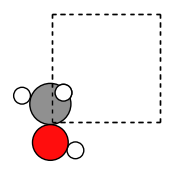AMSCalculator: ASE geometry optimizer with AMS forces¶
Note: This example requires AMS2023 or later.
Note
Follow this example only if you need to use ASE. If you just want to run a normal AMS single-point or geometry optimization, do not go through ASE but instead see the Geometry Optimization of Water example.
Example illustrating how to use the ASE Calculator for AMS. The BFGS geometry optimizer from ASE is used together with AMS-calculated forces (negative gradients).
In this example, the AMS driver is replaced by ASE tools, that use the AMS engines (ADF, BAND, DFTB, ForceField, …) to calculate energies and forces.
See also
In the Engine ASE: AMS geometry optimizer with forces from any ASE calculator example, the AMS engines are instead replaced with external ASE calculators, that can be coupled to AMS driver tasks (GeometryOptimization, TransitionStateSearch, MolecularDynamics, …).
Note
This example launches AMS in “AMSworker” mode. This means that AMS is only started at the beginning of the calculation.
To follow along, either
Download
ASECalculator.py(run as$AMSBIN/amspython ASECalculator.py).Download
ASECalculator.ipynb(see also: how to install Jupyterlab in AMS)
Worked Example¶
Initial imports¶
from scm.plams import *
from scm.plams.interfaces.adfsuite.ase_calculator import AMSCalculator
from ase.optimize import BFGS
from ase.build import molecule as ase_build_molecule
from ase.visualize.plot import plot_atoms
import matplotlib.pyplot as plt
# In this example AMS runs in AMSWorker mode, so we have no use for the PLAMS working directory
# Let's delete it after the calculations are done
config.erase_workdir = True
# this line is not required in AMS2025+
init()
PLAMS working folder: /path/plams/examples/ASECalculator/plams_workdir
Construct an initial system¶
Here, we use the molecule() from ase.build to construct an ASE Atoms object.
You could also convert a PLAMS Molecule to the ASE format using toASE().
atoms = ase_build_molecule("CH3OH")
# alternatively:
# atoms = toASE(from_smiles('CO'))
atoms.set_pbc((True, True, True)) # 3D periodic
atoms.set_cell([4.0, 4.0, 4.0]) # cubic box
# plot the atoms
plt.figure(figsize=(2, 2))
plt.axis("off")
plot_atoms(atoms, scale=0.5);

Set the AMS settings¶
First, set the AMS settings as you normally would do:
s = Settings()
s.input.ams.Task = "SinglePoint" # the geometry optimization is handled by ASE
s.input.ams.Properties.Gradients = "Yes" # ensures the forces are returned
s.input.ams.Properties.StressTensor = "Yes" # ensures the stress tensor is returned
# Engine definition, could also be used to set up ADF, ReaxFF, ...
s.input.ForceField.Type = "UFF"
# run in serial
s.runscript.nproc = 1
Run the ASE optimizer¶
print("Initial coordinates:")
print(atoms.get_positions())
with AMSCalculator(settings=s, amsworker=True) as calc:
atoms.calc = calc
optimizer = BFGS(atoms)
optimizer.run(fmax=0.27) # optimize until forces are smaller than 0.27 eV/ang
print(f"Optimized energy (eV): {atoms.get_potential_energy()}")
print("Optimized coordinates:")
print(atoms.get_positions())
Initial coordinates:
[[-0.047131 0.664389 0. ]
[-0.047131 -0.758551 0. ]
[-1.092995 0.969785 0. ]
[ 0.878534 -1.048458 0. ]
[ 0.437145 1.080376 0.891772]
[ 0.437145 1.080376 -0.891772]]
Step Time Energy fmax
BFGS: 0 14:38:52 0.424475 3.0437
BFGS: 1 14:38:52 0.354817 2.8239
BFGS: 2 14:38:52 0.270256 0.9678
BFGS: 3 14:38:52 0.223897 0.6128
BFGS: 4 14:38:52 0.200223 0.5503
BFGS: 5 14:38:52 0.196200 0.1861
Optimized energy (eV): 0.19620006656661274
Optimized coordinates:
[[-7.36222829e-02 6.46660224e-01 -3.68476800e-17]
[-4.27710560e-02 -7.22615924e-01 2.05712990e-18]
[-1.12651815e+00 9.85598502e-01 -1.78482333e-18]
[ 9.22587449e-01 -9.45309675e-01 1.18153964e-17]
[ 4.42945518e-01 1.01179194e+00 9.09790370e-01]
[ 4.42945518e-01 1.01179194e+00 -9.09790370e-01]]
Complete Python code¶
#!/usr/bin/env amspython
# coding: utf-8
# ## Initial imports
from scm.plams import *
from scm.plams.interfaces.adfsuite.ase_calculator import AMSCalculator
from ase.optimize import BFGS
from ase.build import molecule as ase_build_molecule
from ase.visualize.plot import plot_atoms
import matplotlib.pyplot as plt
# In this example AMS runs in AMSWorker mode, so we have no use for the PLAMS working directory
# Let's delete it after the calculations are done
config.erase_workdir = True
# this line is not required in AMS2025+
init()
# ## Construct an initial system
# Here, we use the ``molecule()`` from ``ase.build`` to construct an ASE Atoms object.
#
# You could also convert a PLAMS Molecule to the ASE format using ``toASE()``.
atoms = ase_build_molecule("CH3OH")
# alternatively:
# atoms = toASE(from_smiles('CO'))
atoms.set_pbc((True, True, True)) # 3D periodic
atoms.set_cell([4.0, 4.0, 4.0]) # cubic box
# plot the atoms
plt.figure(figsize=(2, 2))
plt.axis("off")
plot_atoms(atoms, scale=0.5)
# ## Set the AMS settings
#
# First, set the AMS settings as you normally would do:
s = Settings()
s.input.ams.Task = "SinglePoint" # the geometry optimization is handled by ASE
s.input.ams.Properties.Gradients = "Yes" # ensures the forces are returned
s.input.ams.Properties.StressTensor = "Yes" # ensures the stress tensor is returned
# Engine definition, could also be used to set up ADF, ReaxFF, ...
s.input.ForceField.Type = "UFF"
# run in serial
s.runscript.nproc = 1
# ## Run the ASE optimizer
print("Initial coordinates:")
print(atoms.get_positions())
with AMSCalculator(settings=s, amsworker=True) as calc:
atoms.calc = calc
optimizer = BFGS(atoms)
optimizer.run(fmax=0.27) # optimize until forces are smaller than 0.27 eV/ang
print(f"Optimized energy (eV): {atoms.get_potential_energy()}")
print("Optimized coordinates:")
print(atoms.get_positions())